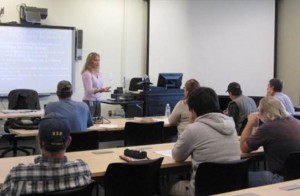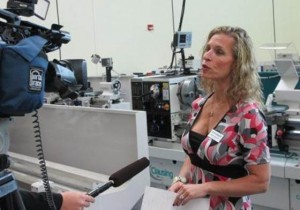“Navigators” Steer Students Into Aerospace Careers
In the last year and a half, a group of community and technical colleges and their WorkSource partners across the state have helped to certify more than 750 people for aerospace jobs through a project called Air Washington.

Mary Stanton teaches a résumé-writing class at Spokane Community College to a group of Air Washington students.
Funded by a three-year, $20 million U.S. Department of Labor grant, Air Washington is aiming to train 2,615 people for aerospace jobs throughout the state by fall 2014. Now about halfway through the grant, training in aircraft maintenance and assembly, electronics, machining and composites manufacturing is under way at 11 community colleges around the state.
The grant does not sponsor students. Rather, it pays for developing and expanding the courses needed to train workers for jobs specific to Washington’s aerospace employers. It also pays for Air Washington navigators: liaisons between the colleges, students and employers. Some are employed by Employment Security, but most by workforce development councils.
“Navigators are on site at the local community colleges and WorkSource offices, and [they] see students daily to help…remove potential barriers to being successful in school,” said Mary Stanton, a navigator working out of WorkSource Spokane and Spokane Community College, which administers the grant. Stanton is employed by Career Path Services, the agency receiving Air Washington grant funds through the Spokane Area Workforce Development Council.

Mary Stanton talks to a local TV station about Air Washington in a Spokane Community College machining classroom.
“As a navigator, my job is to help my students get to work following their education,” Stanton said. “The biggest part of my job is the job-placement piece, which consists of working with [a core of about 40] local employers…so that they see the value of our current and future graduates.
“I also am responsible for promoting new classes and disciplines…and to help students get funding to help pay for all or most of their education,” she said. “This position is a…bridge between the community colleges, WorkSource offices and aerospace [employers].”
In Omak, Laurie Miller (right) is the Air Washington navigator. As an Employment Security employee at WorkSource Okanogan County, she spends 30 to 40 percent of her time as a navigator and the rest of her time as a WorkSource specialist.
“My role as navigator is to support students in the new, two-year aerospace electronics program at Wenatchee Valley College, Omak campus,” Miller said. “Eleven Okanogan County residents enrolled…and are reporting they love it. They’re learning wiring diagrams and schematics, industrial safety and are gearing up for applied electricity and digital electronics.
“In the early stages of the program, I focused on outreach and recruitment,” Miller said. “All potential students were provided an orientation and appropriate career assessments to include basic skill levels.

An Air Washington student at Wenatchee Valley College in Omak learns how to use low voltage to operate a high-voltage switch.
“Now, I visit students in the classroom and observe presentations, labs, etc.,” said Miller. “I meet with them to make sure they have the resources they need to be successful. I refer them to community partners and other resources as necessary…and assist them with scholarships. I also develop relationships with potential employers in the area.
“Over the next two quarters, we will begin to focus on job readiness and…on [making the transition] to employment,” Miller said.
Patrick O’Halloran, who works to steer veterans to Air Washington courses, believes the navigators are essential to the success of the program.
“The word ‘navigator’ is apt, because there are so many details students need to know about and so many potential sources of support,” said O’Halloran, who is based at Spokane Community College. “That personal contact is so valuable, especially for veterans.”
“The strategic nature of this grant has meant the biggest and most rewarding experience for most navigators,” said Stanton. “We have learned the art of coordination of resources, walking among many different state agencies, veteran’s organizations, non-profits, WorkSource centers and community colleges. Each community partner has different restrictions and guidelines and ways of doing business.”
By the end of winter quarter 2013, Air Washington enrolled 2,047 students in training. Of those, 762 of them have received certificates of completion, and 34 have completed associate degrees.
At least 246 of those with certificates are now working. More than 220 of the total number trained are veterans.
Although the program struggles with challenges, such as lower-than-expected wages offered by some employers, students are reporting positive results.
“Six months ago, I…didn’t really know where I was going or what I was going to do with my life. I went from working at a minimum-wage job to working in aerospace production, making a lot more than that,” said a student who found out about Air Washington through WorkSource.
Employers also tout the benefits of Air Washington.
“As an agriculture-aviation manufacturer in rural Eastern Washington…finding aviation workforce talent is a challenge,” said Tom Welch of Cascade Aircraft Conversions, an aircraft-parts engineering firm. “In the search for our last airframe and power-plant mechanic, I reached out to…Mary Stanton…representing Air Washington’s services. Not only did [Mary and her team] locate [the mechanic] we hired, they helped us complete the state and federal paperwork to receive workforce-training reimbursement and tax incentives.”
Although only 246 students so far have jobs as a result of Air Washington, that number should begin to rise faster now, said O’Halloran of Spokane Community College.
“Building the infrastructure was our first task,” he said. “We had to hire staff to design the courses, teach, enroll students, etc. There are going to be a lot more students flowing now that the pipeline has been built.”
By Ann Hartman, Communications Office, ESD

Comments are closed.